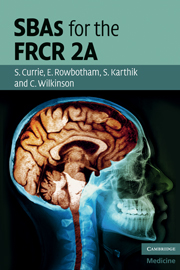Book contents
- Frontmatter
- Contents
- List of contributors
- Preface
- Introduction
- Module 1 Cardiothoracic and vascular
- Module 2 Musculoskeletal and trauma
- Module 3 Gastro-intestinal
- Module 4 Genito-urinary, adrenal, obstetrics & gynaecology and breast
- Module 5 Paediatric
- Questions
- Answers
- Module 6 Central nervous and head & neck
- References
- Index
Questions
Published online by Cambridge University Press: 06 July 2010
- Frontmatter
- Contents
- List of contributors
- Preface
- Introduction
- Module 1 Cardiothoracic and vascular
- Module 2 Musculoskeletal and trauma
- Module 3 Gastro-intestinal
- Module 4 Genito-urinary, adrenal, obstetrics & gynaecology and breast
- Module 5 Paediatric
- Questions
- Answers
- Module 6 Central nervous and head & neck
- References
- Index
Summary
1. A ten year old boy complaining of generalised back pain is referred by his GP for a thoracic spine plain film which shows anterior vertebral body scalloping. Which of the following would be a cause of anterior vertebral body scalloping?
a. Neurofibromatosis
b. Acromegaly
c. Achondroplasia
d. Ehlers–Danlos syndrome
e. Down's syndrome
2. A ten day old baby is referred for a hip ultrasound as clinical examination has revealed a ‘clicky’ right hip. Which of the following parameters is reassuring for a normal hip joint?
a. Alpha angle >60°
b. Alpha angle <60°
c. Beta angle >77°
d. 25% coverage of the femoral head
e. Acetabular angle >30°
3. A two week old neonate presents with central cyanosis and respiratory distress. Plain chest radiograph reveals pulmonary plethora. Which is the most likely underlying congenital heart disease?
a. VSD
b. Tetralogy of Fallot
c. PDA
d. Pulmonary stenosis
e. Total anomalous pulmonary venous return (TAPVC)
4. A 16 year old presents with recurrent pneumothoraces. Past history reveals the presence of a lytic lesion of the parietal bone with a tender soft-tissue mass. Which of the following features is most likely seen on HRCT?
a. Evenly distributed smooth thin-walled cysts
b. Centrilobular nodules
c. Extensive paraseptal emphysema with bulla formation
d. Sparing of the apices
e. Cystic lesions along the course of the bronchial tree
5. A ten year old boy presents with a history of progressive gait abnormalities. Plain radiographs of the thoraco-lumbar spine show widening of the spinal canal at T8-L1. MRI demonstrates an eccentric, ill-defined, homogeneous intramedullary lesion which is hypointense to the cord on T1 and hyperintense on T2.
- Type
- Chapter
- Information
- SBAs for the FRCR 2A , pp. 101 - 113Publisher: Cambridge University PressPrint publication year: 2010



